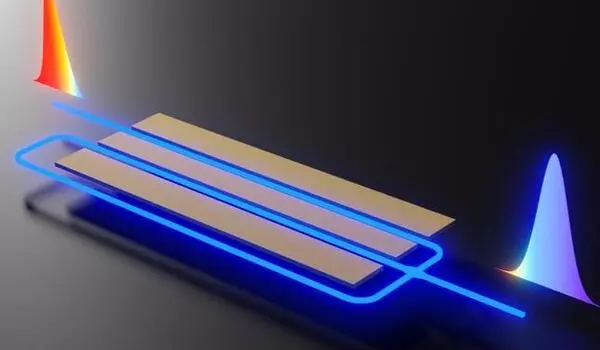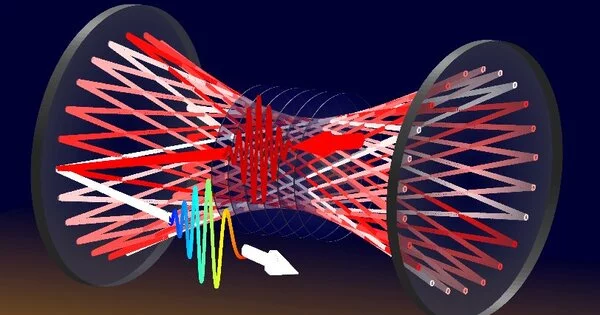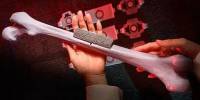Using a time lens, researchers created a high-performance, on-chip femtosecond pulse source. Femtosecond pulsed lasers, which emit light in ultrafast bursts lasting a millionth of a billionth of a second, are powerful tools used in a wide range of applications, including medicine, manufacturing, sensing, and precision measurements of space and time. These lasers are typically expensive table-top systems today, limiting their use in applications with size and power consumption constraints.
A femtosecond pulse source on a chip would enable new applications in quantum and optical computing, astronomy, optical communications, and other fields. However, integrating tunable and highly efficient pulsed lasers onto chips has proven difficult.
Now, researchers from the Harvard John A. Paulson School of Engineering and Applied Sciences (SEAS) have developed a high-performance, on-chip femtosecond pulse source using a tool that seems straight out of science fiction: a time lens.
The research is published in Nature.
We’ve demonstrated that integrated photonics offers simultaneous improvements in energy consumption and size. There is no tradeoff here; you save energy while also saving space. Imagine carrying around femtosecond pulse lasers in our pockets to sense how fresh fruit is or track our well-being in real time, or in our cars to measure distance.
Mengjie Yu
“Pulsed lasers that produce high-intensity, short pulses of many colors of light have remained large,” said Marko Lon?ar, senior author of the study and the Tiantsai Lin Professor of Electrical Engineering at SEAS. “To make these sources more practical, we decided to scale down a well-known approach used to realize conventional (and large) femtosecond sources, leveraging a cutting-edge integrated photonics platform that we developed. Importantly, our chips are manufactured using microfabrication techniques similar to those used to manufacture computer chips, resulting in not only lower cost and size, but also improved performance and reliability of our femtosecond sources.”
Traditional lenses, like contact lenses or those found in magnifying glasses and microscopes, bend rays of light coming from different directions by altering their phase so that they hit the same location in space – the focal point.
Time lenses, on the other hand, “bend” light beams in similar ways – but they alter the phase of light beams in time rather than space. In this way, different colors of light, which travel at different speeds, are re-timed so that they each hit the focal plane at the same time.

Consider a car race in which each color of light represents a different car. The time lens first staggers each car’s departure time, then sets their speed so that they all arrive at the finish line at the same time. To generate femtosecond pulses, the team’s device uses a series of optical waveguides, couplers, modulators, and optical grating on the lithium niobate platform pioneered by Lon?ar’s lab.
The researchers begin by passing a continuous-wave, single-color laser beam through an amplitude modulator, which controls the amount of light that passes through the time-lens, similar to how an aperture in a conventional lens works. The light then passes through the “bendy” part of the lens, a phase modulator in this case, to generate a frequency comb of different colors. Going back to the car analogy, the phase modulator creates and then releases the cars of different colors at different starting times.
Then the final component of the laser comes in – a fishbone grating along the waveguide. The grating changes the speed of the different colors of light to bring them all in line with each other, neck and neck in the race, so that they hit the finish line (or focal plane) at the same time
Because the device controls how fast different wavelengths travel and when they hit the focal plane, it effectively transforms the continuous, single-color laser beam into a broadband, high-intensity pulse source that can produce ultra-fast, 520 femtosecond bursts. The device is highly tunable, integrated onto a 2cm by 4mm chip, and, because of lithium niobate’s electro-optical properties, requires significantly reduced power than table-top products.
“We’ve demonstrated that integrated photonics offers simultaneous improvements in energy consumption and size,” said Mengjie Yu, the study’s first author, and a former SEAS postdoctoral fellow. “There is no tradeoff here; you save energy while also saving space. You just get better performance as the device gets smaller and more integrated. Imagine carrying around femtosecond pulse lasers in our pockets to sense how fresh fruit is or track our well-being in real-time, or in our cars to measure distance.”
Yu is currently a lecturer at the University of Southern California. Following that, the team intends to investigate some of the applications for both the laser and the time lens technology, such as lensing systems like telescopes, ultrafast signal processing, and quantum networking.
















